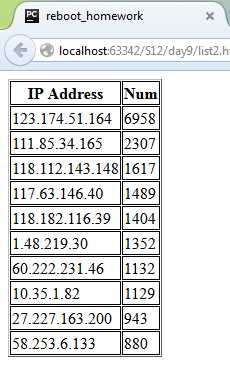标签:函数实现 start 传参 字符 索引 har pytho test 日志文件
作业需求:
作业1:将nginx日志通过python脚本处理取出TOP10的IP地址和访问次数通过html页面的形式展现出来
作业2:通过python函数的方式实现用户注册、登录脚本的实现
作业代码1:
1 #/usr/bin/env python 2 #coding:utf-8 3 4 import time 5 6 start = time.clock() 7 8 # 定义一个空字典 9 nginxip = {} 10 11 # 打开一个文件以readlines方式进行读取所有行 12 with open(‘access.txt‘) as f: 13 logs = f.readlines() 14 15 # 循环日志文件以空格为分隔符截取位置为0及IP这个元素 16 for line in logs: 17 ip = line.split()[0] 18 19 # 判断ip出现的次数分别以计数的方式写入字典里 20 if ip in nginxip: 21 nginxip[ip] += 1 22 else: 23 nginxip[ip] = 1 24 25 # 定义一个新列表,使用sorted进行降序排列,使用key排序,截取前十个IP 26 list = sorted(nginxip.iteritems(),key=lambda x:x[1],reverse=True)[:10] 27 28 #定义一个html文件,根据html的编排格式写到html文件,然后将k/v的值分别循环写入已经编排好的html边框里面 29 f = open(‘list2.html‘,‘a+‘) 30 f.write("<html><table whith=‘400‘ border=‘1‘ cellpadding=‘1‘‘ cellspacing=‘1‘>") 31 f.write("<title>reboot_homework</title>") 32 f.write("<th style=‘border:solid 1px‘>IP Address</th><th style=‘border:solid 1px‘>Num</th>") 33 # 遍历list列表,enumerate会将该数据对象组合为一个索引序列,同时列出数据和数据下标 34 for k,v in list: 35 f.write(‘<tr><td style="border:solid 1px">%s</td><td style="border:solid 1px">%s</td></tr>‘ % (k,v)) 36 print "访问IP和次数:%s --> %s" %(k,v) 37 38 f.write("</table></html>") 39 f.close() 40 end = time.clock() 41 print "统计运行时间: %f s" % (end - start)
代码运行结果1:

作业代码2:
1 #!/usr/bin/env python 2 #coding:utf-8 3 4 ‘‘‘ 5 通过函数实现用户注册、登陆python脚本 6 ‘‘‘ 7 8 9 # 定义一个登陆函数,在这里并不需要参数 10 def login(): 11 12 # 使用input获得用户输入的字符串判断是否存在test文件中 13 username = raw_input("please input your name:").strip() 14 # 定义一个文件并赋予可读的权限 15 login_file = open(‘/Users/guanqing/PycharmProjects/reboot15/day3/test‘,‘r‘) 16 # for循环这个文件并通过‘:‘的格式将用户名和密码传参到usernum和passwordnum 17 for line in login_file.readlines(): 18 print line.strip().split(‘:‘) 19 usernum,passwordnum = line.strip().split(‘:‘) 20 # 判断用户以及密码是否正确,用户名和密码错误的时候有相应的提示 21 if username == usernum: 22 pass01 = raw_input("please input your password:").strip() 23 if pass01 == passwordnum: 24 return "welcome to login." 25 else: 26 return "your password is wrong." 27 else: 28 return "your username is wrong." 29 login_file.close() 30 31 # 定义一个注册函数 32 def register(): 33 # 定义一个文件并赋予权限读写权限 34 register_file = open(‘/Users/guanqing/PycharmProjects/reboot15/day3/test‘, ‘a+‘) 35 username = raw_input("please input your name:").strip() 36 # 判断用户输入是否为空 37 if len(username) == 0: 38 return "your username can‘t empty." 39 else: 40 # 判断用户输入的密码是否正确以及是否为空 41 password = raw_input("please input your password:").strip() 42 repassword = raw_input("please input your password again:").strip() 43 if password != repassword or len(password) == 0: 44 return "the password is wrong. " 45 else: 46 # 将用户输入的账号信息写入到test文件里 47 register_file.write("%s:%s\n" %(username,password)) 48 register_file.close() 49 return "congratulations, your register is success." 50 51 # 通过input的方式判断并调用函数 52 def start(): 53 action = raw_input("please select:register/login:").strip() 54 if action == "login": 55 res = login() 56 elif action == "register": 57 res = register() 58 else: 59 return "your input is wrong." 60 61 return res 62 63 print start()
标签:函数实现 start 传参 字符 索引 har pytho test 日志文件
原文地址:http://www.cnblogs.com/guanqingye/p/7326642.html